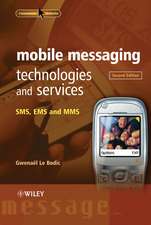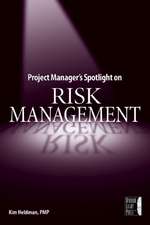CompTIA Project+ Study Guide: Exam PK0–005 3rd Edition: Sybex Study Guide
Autor K Heldmanen Limba Engleză Paperback – 5 oct 2022
Din seria Sybex Study Guide
- 20%
 Preț: 204.34 lei
Preț: 204.34 lei - 20%
 Preț: 204.48 lei
Preț: 204.48 lei -
 Preț: 416.00 lei
Preț: 416.00 lei - 20%
 Preț: 204.15 lei
Preț: 204.15 lei - 20%
 Preț: 272.31 lei
Preț: 272.31 lei - 20%
 Preț: 467.73 lei
Preț: 467.73 lei - 20%
 Preț: 343.55 lei
Preț: 343.55 lei - 20%
 Preț: 205.15 lei
Preț: 205.15 lei - 20%
 Preț: 289.38 lei
Preț: 289.38 lei - 20%
 Preț: 272.52 lei
Preț: 272.52 lei -
 Preț: 322.04 lei
Preț: 322.04 lei - 20%
 Preț: 304.02 lei
Preț: 304.02 lei -
 Preț: 351.32 lei
Preț: 351.32 lei -
 Preț: 404.31 lei
Preț: 404.31 lei - 20%
 Preț: 175.26 lei
Preț: 175.26 lei -
 Preț: 325.22 lei
Preț: 325.22 lei -
 Preț: 288.65 lei
Preț: 288.65 lei -
 Preț: 383.42 lei
Preț: 383.42 lei - 20%
 Preț: 399.67 lei
Preț: 399.67 lei - 8%
 Preț: 439.48 lei
Preț: 439.48 lei -
 Preț: 427.33 lei
Preț: 427.33 lei - 8%
 Preț: 365.36 lei
Preț: 365.36 lei - 8%
 Preț: 441.16 lei
Preț: 441.16 lei - 20%
 Preț: 274.58 lei
Preț: 274.58 lei -
 Preț: 322.04 lei
Preț: 322.04 lei -
 Preț: 410.24 lei
Preț: 410.24 lei - 20%
 Preț: 298.45 lei
Preț: 298.45 lei - 20%
 Preț: 274.41 lei
Preț: 274.41 lei -
 Preț: 257.89 lei
Preț: 257.89 lei - 20%
 Preț: 289.17 lei
Preț: 289.17 lei - 20%
 Preț: 309.98 lei
Preț: 309.98 lei - 20%
 Preț: 221.89 lei
Preț: 221.89 lei - 20%
 Preț: 408.48 lei
Preț: 408.48 lei - 20%
 Preț: 276.82 lei
Preț: 276.82 lei - 20%
 Preț: 278.23 lei
Preț: 278.23 lei -
 Preț: 326.42 lei
Preț: 326.42 lei - 20%
 Preț: 224.76 lei
Preț: 224.76 lei -
 Preț: 294.97 lei
Preț: 294.97 lei -
 Preț: 291.72 lei
Preț: 291.72 lei -
 Preț: 321.94 lei
Preț: 321.94 lei - 20%
 Preț: 281.57 lei
Preț: 281.57 lei - 20%
 Preț: 251.37 lei
Preț: 251.37 lei -
 Preț: 324.94 lei
Preț: 324.94 lei - 20%
 Preț: 308.58 lei
Preț: 308.58 lei -
 Preț: 432.32 lei
Preț: 432.32 lei -
 Preț: 407.96 lei
Preț: 407.96 lei - 20%
 Preț: 286.59 lei
Preț: 286.59 lei -
 Preț: 340.54 lei
Preț: 340.54 lei - 20%
 Preț: 280.68 lei
Preț: 280.68 lei
Preț: 260.97 lei
Nou
Puncte Express: 391
Preț estimativ în valută:
49.94€ • 52.14$ • 41.33£
49.94€ • 52.14$ • 41.33£
Carte disponibilă
Livrare economică 15-29 martie
Livrare express 01-07 martie pentru 45.33 lei
Preluare comenzi: 021 569.72.76
Specificații
ISBN-13: 9781119892458
ISBN-10: 1119892457
Pagini: 480
Dimensiuni: 187 x 235 x 27 mm
Greutate: 0.69 kg
Editura: Sybex
Seria Sybex Study Guide
Locul publicării:Hoboken, United States
ISBN-10: 1119892457
Pagini: 480
Dimensiuni: 187 x 235 x 27 mm
Greutate: 0.69 kg
Editura: Sybex
Seria Sybex Study Guide
Locul publicării:Hoboken, United States
Notă biografică
ABOUT THE AUTHOR Kim Heldman, MBA, PMP, is Senior Manager and IT/Chief Information Officer for the Regional Transportation District in Denver, Colorado. She has over 25 years' experience in IT project management and directs IT resource planning, budgeting, project prioritization, and strategic and tactical planning. Learn more about her at www.kimheldman.com.
Descriere scurtă
Cuprins
Introduction xxi Assessment Test xxx Chapter 1 Introducing the Project 1 Defining the Project 2 Identifying the Project 2 Programs and Portfolios 3 Understanding Operations 4 Using the PMBOK(r) Guide 5 Project Life Cycle Phases 5 Discovery Phase 6 Initiating Phase 6 Planning Phase 7 The Executing Phase 9 The Closing Phase 10 Performing the Discovery/Concept Preparation Phase 10 How Projects Come About 11 Creating the Business Case and Selecting Projects 13 Determining Benefits and Rewards 14 Examining Existing Artifacts 21 Project Selection Methods 23 Decision Models 24 Expert Judgment 25 Summary 25 Exam Essentials 26 Key Terms 27 Review Questions 28 Chapter 2 Understanding IT Fundamentals 33 Understanding the Role of the Project Manager 34 Leadership 35 Communication 35 Problem Solving 36 Negotiating 36 Organization and Time Management 37 Factors That Influence Project Management Activities 38 Environmental, Social, and Governance (ESG) Factors 38 Compliance and Privacy Considerations 40 Information Technology Fundamentals 46 Infrastructure 46 Cloud Models 51 Software 55 Financial Systems 60 Summary 62 Exam Essentials 64 Key Terms 65 Review Questions 67 Chapter 3 Creating the Project Charter 71 Identifying and Assessing Stakeholder Roles and Responsibilities 72 The Customer and End Users 73 The Project Sponsor 74 The Project Manager 75 The Senior Management Team 76 The Business Analyst 76 The Subject Matter Experts 76 The Project Management Office 77 The Program Manager 77 The IT Team 78 The Stakeholder Register 79 Assessing Stakeholders 80 Creating the Preliminary Scope Statement 83 Understanding the Need 84 Documenting the Preliminary Scope Definition 85 Creating the Project Charter 85 Purpose or Justification for the Project 86 Objectives 86 Project Description 87 Key Deliverables 87 High-Level List of Requirements 87 High-Level Milestones 87 Preapproved Budget 88 High-Level Assumptions 88 High-Level Constraints 88 Overall Risks 89 Other Contents 89 Project Success Criteria 89 Formal Approval 90 Creating the Records Management Plan 90 Determining Access Requirements 92 Holding the Kickoff Meeting 93 Summary 98 Exam Essentials 99 Key Terms 101 Review Questions 102 Chapter 4 Planning the Project 107 Defining the Planning Phase 108 Documenting the Scope Management Plan 109 Writing the Scope Statement 110 Project Objectives 111 Project and Product Description 111 Success Criteria and Key Performance Indicators 111 Key Deliverables 112 Exclusions from Scope 112 Time and Cost Estimates 112 Assumptions 113 Constraints 113 Approval of the Scope Statement 118 Documenting the Requirements 119 Requirement Categories 119 The Requirements Document 121 Determining a Project Methodology 122 Projects in Control (PRINCE2) 124 DevOps 124 Development Life Cycle Methodologies 125 Using the Waterfall Methodology 125 Using Agile Methodologies 126 Scrum 127 Kanban 127 Scrumban 129 Lean 129 Extreme Programming 130 Feature-Driven Development 132 Dynamic Systems Development Method 132 Agile Unified Process 133 Hybrid 133 Summary of Project Life Cycles 134 Selecting a Methodology 136 Determining Scope on Agile Projects 138 Agile Team Members 139 Determine a Solutions Design 140 Summary 143 Exam Essentials 145 Key Terms 146 Review Questions 148 Chapter 5 Creating the Project Schedule 153 Creating the Work Breakdown Structure 154 Decomposing the Major Deliverables 155 Guidelines for Creating a WBS 156 Benefits of the WBS 157 WBS Dictionary 158 Scope Baseline 158 Documenting the Project Management Plan 159 Schedule Planning 160 Defining Tasks 161 Task Sequencing 162 Types of Dependencies 162 Logical Relationships 163 Creating a Network Diagram 164 Assigning Resources 164 Determining Task Durations 165 Defining Duration 165 Estimating Techniques 165 Developing the Project Schedule 167 Milestones 168 Program Evaluation and Review Technique 169 Gantt Charts 170 The Critical Path Method 170 Duration Compression 172 Resource Loading 173 Project Scheduling Software 175 Setting the Baseline and Obtaining Approval 175 Quality Gates 176 Establishing Governance Gates 176 Scheduling Techniques Using Agile Methodologies 177 Estimating Techniques Using Agile 177 Burndown Chart 178 Story Points and Velocity 179 Kanban Board 180 Scrum Board 181 Agile Release Planning 182 Summary 185 Exam Essentials 186 Key Terms 188 Review Questions 190 Chapter 6 Resource Planning and Management 195 Understanding Organizational Structures 196 The Functional Organization 196 The Matrix Organization 198 The Projectized Organization 200 Determining Resource Needs 201 Resource Overallocation 203 Interproject Work 203 Resource Life Cycle 204 Personnel Management 206 Team Composition 206 Selecting Team Members 206 Roles and Responsibilities 208 Organization Charts and Position Descriptions 208 Matrix-Based Charts 209 Building and Managing a Cohesive Team 211 Trust Building 212 Monitoring Team Performance 212 Conflict Management 216 Managing Conflict 216 Project Kickoff Part Two 219 Procurement Planning 220 Statement of Work 221 Vendor Solicitation 222 Vendor Selection Criteria 223 Types of Contracts 226 Vendor-Related Documents 228 Summary 230 Exam Essentials 232 Key Terms 233 Review Questions 235 Chapter 7 Defining the Project Budget and Risk Plans 239 Understanding Information Security Concepts 240 Corporate IT Security Policies 240 Categorizing Security Policies 242 Estimating Costs 245 Cost-Estimating Techniques 245 Estimating Tips 249 Creating the Project Budget 250 Creating the Project Budget 251 Cost Baseline 253 Expenditure Tracking and Reporting 254 Budget Burndown Chart 255 Earned Value Management 256 Expenditure Reporting 260 Risk Planning 260 Risk Identification 261 Risk Analysis 263 Preparing Risk Responses 267 Risk Monitoring 270 Summary 272 Exam Essentials 273 Key Terms 275 Review Questions 277 Chapter 8 Communicating the Plan 283 Communications Planning 284 Exchanging Information 285 Listening 287 Methods of Communicating 288 Assessing the Forms of Communication 288 Written and Verbal Communication 289 Communication Methods and Tools 289 The Communication Plan 292 Communicating with Project Team Members 293 Communicating on an Agile Team 294 Factors That Influence Communications 297 Communication Triggers 299 Holding Effective Meetings 302 Meeting Types 302 Preparing for Meetings 305 Communication Platforms 307 Collaboration Tools 307 Meeting Tools 309 Reporting Project Information 310 Project Status Reports 310 Project Dashboard 311 Charts 311 Establishing Communication Channels 313 Maintaining Communication Records 313 Controlling Communications 315 Managing Stakeholder Expectations and Communication Needs 316 Summary 321 Exam Essentials 322 Key Terms 323 Review Questions 325 Chapter 9 Processing Change Requests 329 Executing Phase Activities 330 Reviewing the Project Management Plan 331 Managing Vendors 332 Contract Change Control 333 Paying Vendors 334 Implementing Change Control Systems 335 Create and Submit the Change Request 336 Documenting Changes in the Change Control Log and Conducting a Preliminary Review 336 Conducting Impact Assessments 337 Documenting Change Recommendations 338 Determining Decision-Makers 339 Managing the Change Control Board 339 Documenting Approval Status in the Change Control Log 340 Communicating Change Status 340 Updating the Project Management Plan 341 Implementing the Change 341 Validating the Change and Perform a Quality Check 342 Communicating Change Deployment 342 Other Change Requests 342 Project Change Management 342 Implementing Organizational Change 343 Types of Organizational Change 343 Implementing Organizational Change 344 Operational Change Control on an IT Project 347 IT Infrastructure Control 347 Software Change Control 348 Other IT Change Processes 349 Agile Frameworks 349 Scaling Frameworks 350 Projects in Control (PRINCE2) 351 Summary 353 Exam Essentials 354 Key Terms 355 Review Questions 357 Chapter 10 Managing Quality and Closing Out the Project 363 Controlling Quality 364 Inspecting and Testing 364 Using Quality Charts 366 Common Causes of Variances 372 Taking Action on Quality Control 373 Managing Issues 374 Roles and Responsibilities 374 Issue Tracking 374 Resolution Plan 375 Resolution Techniques 376 Outcome Documentation 376 Action Items 376 Using Performance Measures 377 Key Performance Indicators 377 Balanced Scorecard 379 Key Objectives and Results 379 Cost and Schedule Performance 379 Project Endings 380 Characteristics of Closing 380 Types of Project Endings 380 Steps in Closing Out a Project 382 Verification and Validation of Deliverables 382 Obtaining Sign-Off 383 Developing a Transition Plan and Operational Handoff 383 Removing Access 384 Releasing Team Members 384 Closing Out the Contract 384 Archiving Documentation 385 Documenting Lessons Learned and Project Evaluation 385 Project Closure Meeting 388 Project Closeout Report 388 Rewards and Celebrations 389 Postimplementation Support and Warranty Period 389 Summary 390 Exam Essentials 391 Key Terms 393 Review Questions 394 Appendix Answers to Review Questions 399 Chapter 1: Introducing the Project 400 Chapter 2: Understanding IT Fundamentals 401 Chapter 3: Creating the Project Charter 403 Chapter 4: Planning the Project 404 Chapter 5: Creating the Project Schedule 406 Chapter 6: Resource Planning and Management 408 Chapter 7: Defining the Project Budget and Risk Plans 409 Chapter 8: Communicating the Plan 411 Chapter 9: Processing Change Requests 413 Chapter 10: Managing Quality and Closing Out the Project 414 Index 417






















